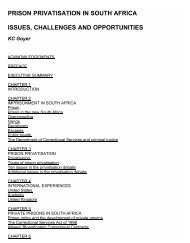S outh A frican Police Service - Institute for Security Studies
S outh A frican Police Service - Institute for Security Studies
S outh A frican Police Service - Institute for Security Studies
You also want an ePaper? Increase the reach of your titles
YUMPU automatically turns print PDFs into web optimized ePapers that Google loves.
The Strategic Plan 2010 to 2014<br />
12<br />
4. STRATEGIC PRIORITIES OF THE SAPS<br />
The SAPS has identified a number of broad, strategic priorities that will direct its annual<br />
planning <strong>for</strong> the period 2010 to 2014. These strategic priorities are subdivided into<br />
operational priorities, i.e. those priorities directed at the SAPS’ core functions in terms of<br />
Section 205 of the Constitution; and the organisational priorities, or those priorities aimed at<br />
the managing of the SAPS’ resources.<br />
4.1 Operational Strategic Priorities<br />
4.1.1 Crime Prevention<br />
4.1.1.1 Reduction of Crime Levels<br />
The reduction of crime levels, specifically the “TRIO crimes” and crimes against<br />
women and children, including domestic violence, which despite continued<br />
success during the past, remains a challenging task given the prevailing socioeconomic<br />
conditions in the country. This is an objective that the SAPS can’t achieve<br />
on its own and will require an integrated approach involving all communities and<br />
spheres of Government. The developing and implementation of an intelligencedriven,<br />
integrated and comprehensive crime prevention strategy will ensure<br />
this integrated approach. The reduction of illegal firearms, and the addressing of<br />
substance abuse, which are significant contributory factors in serious and violent<br />
crime in the country, will be addressed within the context of the strategy.<br />
Increasing the visibility of SAPS personnel members, particularly at station level,<br />
is a priority and includes the focused patrolling of cities and highways, in<strong>for</strong>med<br />
by identified crime tendencies and patterns and the appropriate use of Tactical<br />
Response Teams. Significant strides have been made in increasing the number<br />
of police officials within the visible policing environment, however, it has become<br />
necessary to re-evaluate the manner in which resources are being utilized, thereby<br />
improving the effective use of current resources. Various strategies will continue to<br />
be used to improve the effectiveness of visible policing, examples of which include<br />
the strengthening of police stations where there is a high occurrence of crime (high<br />
contact crime stations), the utilisation of <strong>for</strong>ce multipliers (e.g. Metro <strong>Police</strong>) and<br />
partnership policing and sector policing.<br />
The medium-term target <strong>for</strong> the Crime Prevention Strategic Priority will be focused on<br />
the reduction of levels of all serious crime by between 4-7% over the medium-term<br />
period. In addition, the target <strong>for</strong> the reduction of levels of contact crime has been set<br />
at 34% and the target <strong>for</strong> the reduction of TRIO crimes has been set at 31% <strong>for</strong> the<br />
period 2010 - 2014.<br />
4.1.1.2 Improving <strong>Police</strong> Response<br />
Improving the police response times is an objective that remains a priority <strong>for</strong> the<br />
Department. The successes of the Gauteng 10111 pilot needs to be expanded and<br />
rolled out to other provinces, in support of initiatives to improve response times.

















